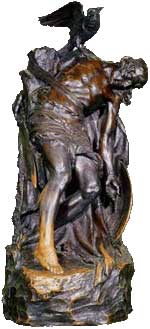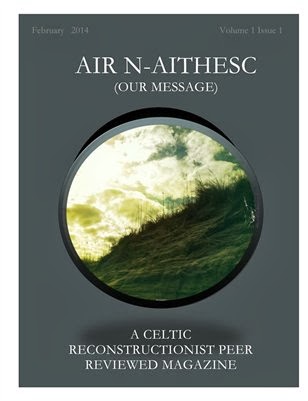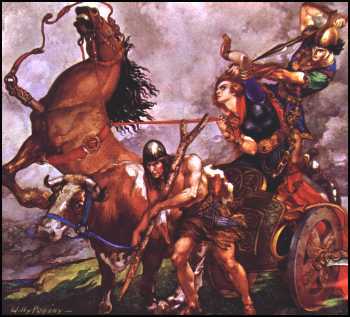 If you find this article helpful, please remember this was work to put together and I have animals to feed and vet
If you find this article helpful, please remember this was work to put together and I have animals to feed and vet
In my earlier post about an Morrígan appearing to Cú Chulainn and offering sex and victory as a test, I noted that this is not featured in all versions of the Táin Bó Cúailnge. Instead, the Book of Leinster edition uses the remscéla (foretale) Táin Bó Regamna, to set up Her coming at him as a heifer, eel and wolf.(TBC pg. 54, 194) The story is, again, read as if showing their hatred of each other and why CC needs to be “punished.” There are several other issues which come up with it, however, which again make no sense if you read it this way and also view the Morrígan as a powerful Goddess.
The Táin Bó Regamna is one of the stories which sets up the circumstances for the Táin Bó Cúailnge, in which the Morrígan essentially sets the entire stream which makes sure Cú Chulainn will play his role. She steals a cow to breed to the Donn Cúailnge, the bull Medb will raid for. Cú Chulainn tries to stop the theft, finding Her all in red in a chariot with a single red, one legged horse with the pole running through it and a man herding the cow. He is first angered that the “woman” answers rather than the man, he even leaps upon Her shoulders. She identifies Herself this time as a satirist, which should at least be a clue as to the words She then gives. The chariot, horse, man and semblance of a woman disappear and She takes the form of a black bird, revealing who She actually is. She seemingly predicts that he will die in a cattle raid when the calf the cow carries is a year old. This gets him angry and he boasts that he will not only survive the raid but will kill all who come against him and will find his fame in it. She then makes the threat of coming against him as eel, wolf and heifer while he counters as to how he will wound Her. She disappears with the cow.
Now it’s often said that in this She is speaking prophecy, yet if we believe She is a powerful Goddess with great prophetic powers, how can this be? She would be, after all, wrong for, as he proclaimed, he didn’t die then. Even a true satire, one meant to create magic which makes the words so, would mean he’d have to die in the TBC…or it means She has little power. So again, we see that if this is taken as it usually is, that they are truly contentious, it shows Her as weak. Perhaps not a problem for some focused on him, but as a follower of Her it is problematic.
So, again, let’s consider what else this might be. What I believe it is is gressacht. This is a form of incitment to battle, using mocking and insult to create rage in the fighter, related to the laíded which Mac Cana demonstrates is incitement through praise.(MacCana, pg 77-78) He notes the War Goddess doing this in his Macgnímrada which is part of the TBC, and that it is obvious what She is doing there despite the term not being used. (MacCana pg. 80) Therefore seeing this in the TBR as well as part of the exchange between them in the TBC which we have discussed, shows a pattern, one fitting the role of a warrior and the Goddess who would wish to incite him.
She is, of course, not the only one using this form of incitement on him nor is he the only one it’s used on. In fact, in his battle with Lóch, when She also attacks him, this form of incitement is used on both of them. The women of Connacht and then Medb taunt Lóch to get him to fight Cú Chulainn. Seeing CC in trouble fighting both the eel-shaped Morrígan and Lóch, Fergus called upon one of the Ulstermen to incite him so that he can defeat them both and Bricriu steps up to the task. (MacCana, pg. 79). But perhaps the best known example is when Cú Chulainn must face his beloved Ferdiad and he asks his charioteer Láeg to incite him in this way. (MacCana, pg. 77-78)
The response, to gressacht is expected to be “I’ll show you!” But wordier then followed with the action. Again, we see exactly this in the paring of the TBR interaction between Cú Chulainn and an Morrígan and the events in the TBC.
The concept of the inciting the warrior into action by verbal insult is hardly unique to early Ireland. Most of us know of the verbal lashing associated with drill sergeants and coaches. The idea, especially in the military, had been to create soldiers who could take pressure. And resist being female, as it’s commonly the featured insult (interestingly, MacCana noted that the Irish insults never use the accusation of being womanly to insult men, pg. 90-91 although I think we might want to look at how it was still used as in insult regarding Medb). However, in light of awareness of bullying’s devastating consequences these methods have been questioned and curbed, although some surely still practice them when possible. We have seen it seep into pop culture “fitness” thanks to Jillian Michaels. In fact, some personal trainers call such abusive tactics “going Jillian Michaels on someone” and, yes, this is considered a very inappropriate way to treat a client.. Because the problem is that uch insulting usually is nothing more than verbal abuse. Bullying. Because for all some might claim it’s for “their own good” it’s really about control. And it’s done without regard for what baggage the person it’s being said to already has.
If someone has grown up with verbal abuse, they have learned from the beginning to not respond positively. They have been taught that “I’ll show you!” is not the sought after response. More of abuse just causes more pain and damage, even if the abuser expects and wants a “I’ll show you!” response. And that’s something we must always be aware of. I am not calling for us to use this as a method….unless the person on the receiving end requests it, like CC asked his charioteer. Not even among my, ahem, cult members, although I think this concept has a place as we’ll get to. In fact, MacCana notes that only certain people seem to have been allowed. Charioteers, women (and there is a heterosexual component with the recipients being male), satirists….Fergus cannot do it, so he calls up on those who can (MacCana pg. 86-89). Obviously, Goddesses would be among those who can.
The fact that verbal insult can demoralize, psych out, rather than provoke, psych up, was also evident in the Irish literature and in sports today. MacCana notes the various times when screams, shouts, taunts and other noise is mentioned in the war literature, either from opposing forces or the War Goddesses.(MacCana, pg. 69-74) This too is used in modern sports, especially seen in fighting sports (and taken to a crazier level in scripted “wrestling”). But we can often see that sometimes it does psych up rather than psych out, as taunts are thrown and countered with “I’ll show you!” (sometimes both almost as poetic as in the literature). Of course, a fighter might want to have their opponent visibly psyched up, it makes for a more glorious fight. We have hardly left the idea that we discussed earlier that a good fighter wants to be known for having a good fight, not an easy win.
As part of that, of course, we again have the laíded, the praise. Not just given by the supporters of the winner or the loser of the winner (part of “good sportsmanship” and “losing well” is to be sure that now everyone knows you lost to someone who was very good, that your skills will benefit from this and “I’ll show you next time!”) but often the winner of the loser. There is no glory in making out the opponent you beat as having no skill, the more skilled they are the more you must have been. We insult, then we praise.
How can we use this today? As I said I think with care, for harming those harmed already is useless. And some of my suggestions are not likely going to sit well with those who might have such backgrounds. I want to say that I think learning to be able to say “I’ll show you!” is a good thing, but I also am well aware that my knowledge of the psychology of it all is far to limited to say how. I think it might be something some may wish to explore with professional help. It’s not something I’m familiar with because the forms of verbal abuse I can identify being an issue for me have been different…it’s been the “friendly, helpful,” sneaky, manipulative backhanded compliment type that “friends” taught me later in life. The overt, insult stuff I learned to blow off as a kid. Not always a “I’ll show you!” but more the belief my mother engendered that people who talked shit about you weren’t people who mattered.
Yet, even those who haven’t been overwhelmed by others’ abusing us sometimes do it to ourselves all the same. And maybe those backhanded compliments which slowly, subtly degrade our self-esteem at the hands of friends have their own way too. So even without the overt abuse, we feel we’re not smart enough, not strong enough, not skilled enough….. And we tell ourselves this.
So it’s the self-talk we may need to first learn to say “I’ll show you!” to. Say it with conviction and say it in poetic detail! And take the action to prove those voices wrong. Get creative with your response to the negative self-talk, hells, have fun with it! Because the way to deal with it from others is to first deal with it in yourself.
Again, this may well be a gross oversimplification for many, so if you’re not do not let that strengthen the bad self-talk instead! Please! There are also times to be gentle with yourself.
And to praise yourself! Never forget that side of it!
I do think there is room, for some, for doing this between two people. There are even situations where some might seek it out. I have realized one for me, something which …well…is a bit odd.
Although my father never insulted my ability with horses that I can remember, I developed at an early age a need to prove myself to him. Perhaps this was actually a response to a sense of protectiveness that the feminist child I was resented? In more recent years I know my father was quite worried about, first, the crazy abuse survivor, Saoradh, I rescued and, later, my crazy filly, Saorsa, but I was determined to show him in both cases. I did with Saoradh who became calm, happy and no longer so violently reactive in his last years. But when he died, I seemed to internalize the worry. I became afraid both of “ruining” her and of getting hurt. I became less self-confident with a horse than I have ever been and I ended up seeking a trainer to work with her. And despite that, I just wasn’t getting ti back. I was getting a great deal of encouragement from my mate and from the trainer…but I couldn’t find it in me.
Then we had a farrier here who flat out told me she was too much horse for me, she’d make a great horse for someone who was confident and I should sell her. And it was like a fucking light switch went off. After that I began working with her myself and progressed greatly. Sadly, when he nearly crippled our other mare we had to find another trimmer and I no longer have his reminder to keep that up. What I do have is a husband confused at why I get annoyed with my doubts come back and he tells me I can do it. Apparently horses are one area where I need someone who makes me say “I’ll show you!” even if they’re not actually taunting me. (maybe someone will read this and take on the role LOL)
Having identified this one place where I seem to need someone to prove myself to, I can see where that need can be used to strengthen myself. I could see a place for ritualized taunting among warriors. I can also feel that the War Goddesses do do this to us, even today. That perhaps “self talk” isn’t…but then don’t we believers often struggle with who might actually be speaking in our heads (and the accusations non-believers might have on that)? And that, really, it might work best as the taunter is on your side, as Bricriu, Láeg and, most assuredly, the Morrígan really were on Cú Chulainn’s. That such interaction is not adversity but aid. That those taunting know, as does the recipient, that the taunts are lies. And that they’ll be there to praise after. But, sometimes, you have to settle for a know it all asshole who can’t even do his own job adequately.
I do know that there are times when a small murder of crows in a tree I’m going buy when I’m just not feeling into a run feels like more than just a group of wild birds squawking at each other, but are aiming gressacht their remarks at me. I know because it brings up the “I’ll show you!” feeling in me. And I know the difference in the run before and after. And I know the feeling when I put a bit more effort in a run and a chorus of coywolves erupts just as it’s coming to an end, that more than just a local pack calling for a hunt, it’s laíded for my effort. Small moments, but we can find strength in the face of insult and we will feel rewarded. We just have to remember, sometimes the One who taunts will give the deepest praise once we show Her.
See also:
The Morrígan and Cú Chulainn: On Saying “No”
The Morrígan and Cú Chulainn pt. 3: Of death and dog meat
I also discuss some of this, as well as expand on the nature of the Morrígan “Musings on the Irish War Goddesses” in By Blood, Bone and Blade: A Tribute to the Morrígan Nicole Bonivusto, ed, Ashville, NC: Bibliotheca Alexandrina, 2014
Bibliography
A. H. Leahy, ed. and trans, “Táin Bó Regamna,” Heroic Romances of Ireland, Volume II London: David Nutt, 1906 Irish English
Proinsias MacCana, “Láided, Gressacht ‘Formalized Incitement’” Érui vol. 43
Cecile O’Rahilly, trans., Táin Bó Cúalnge from Book of Leinster Dublin: Dublin Institute for Advanced Studies, 1967 Irish English
Cecile O’Rahilly, trans. Táin Bó Cúalnge, Recession 1 Dublin: Dublin Institute for Advanced Studies, 1976 Irish English
Copyright © 2013 Saigh Kym Lambert

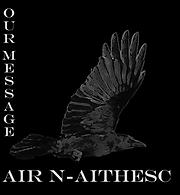
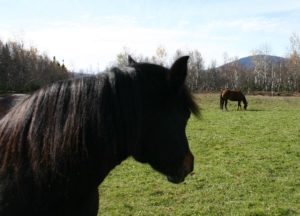

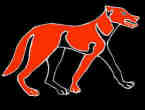 The next issue should be out at Imbolc, in just a few weeks. I will try to post excerpts in a more timely manner at that point. ~;) Or maybe I’ll even blog something else. ~:p
The next issue should be out at Imbolc, in just a few weeks. I will try to post excerpts in a more timely manner at that point. ~;) Or maybe I’ll even blog something else. ~:p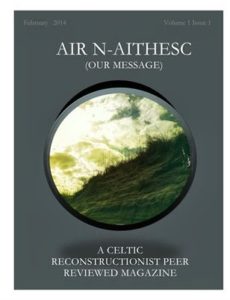
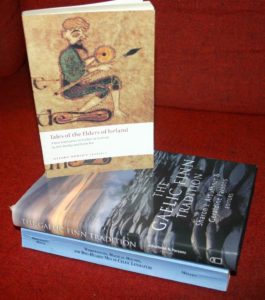 So taking Maya St.Clair’s, who blogs as
So taking Maya St.Clair’s, who blogs as 